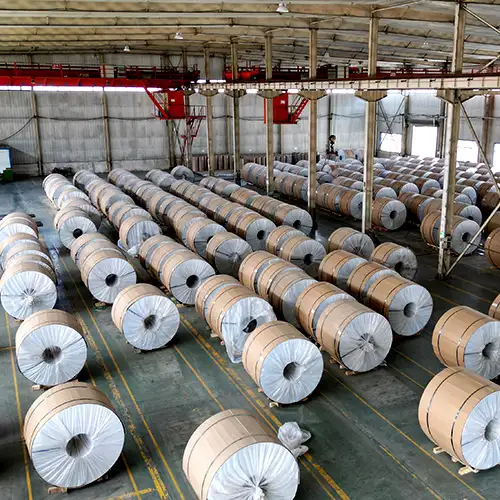Anodizing × Roller Coating: Opening a New Realm of Aluminum Sheet and Coil Decoration
Release time:
2025-07-17
Source:
In the field of aluminum sheet and aluminum coil reprocessing, a single process has long been unable to meet the diversified market demand.
In the field of aluminum sheet and aluminum coil reprocessing, a single process has long been unable to meet the diversified market demand. When the anodizing process and the roller coating process join forces, it is like installing a "dual engine" for aluminum sheets and aluminum coils, which can not only retain the superior performance of the material itself, but also achieve a leapfrog upgrade in decorative effects.
The "golden logic" of process combination
The core of the anodizing process is to form a dense oxide film on the surface of aluminum. This film is like a natural "protective barrier", giving aluminum the "hard power" of wear resistance and corrosion resistance. The roller coating process uses a precision roller to evenly attach the paint to the surface of the material, just like putting a "colorful coat" on the aluminum, which can achieve rich color performance and texture effects.
When the two are combined, anodizing first lays a "foundation" for aluminum - the porous structure of the oxide film can enhance the adhesion of the coating and avoid paint loss and bulging in the later stage; roller coating then "beautifies" - on the basis of a solid oxide film, it gives aluminum a personalized appearance such as matte, metallic glitter, and wood grain. This combination of "protection first, then decoration" makes aluminum sheets and aluminum coils both "durable" and "good-looking".
1+1>2 display effect
A "visual feast" with more lasting colors
Ordinary painting processes are prone to fading due to wear and tear, but after anodizing, the roller-coated colors seem to "grow" on the aluminum. Whether it is the highly saturated Morandi color system or the gradient texture that imitates natural stone, it can remain bright for a long time. When used on the exterior walls of buildings, even after being baptized by wind and rain, it can still maintain a new visual effect after a few years; when used on furniture panels, daily wiping will not leave obvious marks.
A "tactile experience" with a more delicate texture
The surface of anodized aluminum has a delicate texture. When roller-coated, the paint will penetrate evenly along the microstructure of the oxide film, and finally form a "soft and jade-like" touch. Compared with a single process, the combined surface has neither the coldness of pure oxidation nor the plasticity of simple roller coating. When used in interior decoration, it can enhance the sense of luxury of the space through touch.
The core advantage of the combination of processes
Performance and appearance "double online"
The protectiveness of anodizing solves the pain point of "easy to break" of traditional coating, and the decorativeness of roller coating makes up for the shortcoming of "single color" of pure oxidation. For example, on the shell of new energy vehicle charging piles, this combination can not only resist outdoor sun and rain (weather resistance increased by more than 30%), but also integrate with the surrounding environment through customized colors, taking into account practicality and aesthetics.
Cost and efficiency "double optimization"
When the two are combined and operated on an assembly line, "one-time processing, double effects" can be achieved, saving the time cost of secondary processing. At the same time, the oxide film enhances the adhesion of the coating and reduces the cost of later maintenance. In large-scale construction projects, this process can shorten the construction period and reduce the cost of later renovation, with obvious cost-effectiveness.
Application scenarios "borderless"
From the facade of a commercial complex to the panel of a smart home, from the interior of a subway car to the light box of an outdoor advertisement, the aluminum sheet and aluminum coil produced by the combined process can do the job. For example, the curved curtain wall of a high-end shopping mall uses champagne gold aluminum plates with "anodized + roller coating", which not only meets the molding requirements of curved surface processing, but also enhances the brand tone of the shopping mall through the metal texture.
When the "hard-core protection" of anodizing meets the "flexible decoration" of roller coating, there are more possibilities for the reprocessing of aluminum plates and aluminum coils. This process combination is not only a technological innovation, but also a precise response to market demand - allowing each piece of aluminum to stand the test of time and become the "face value" in the scene. In the future, as the process continues to run-in and upgrade, they will also unlock new applications in more fields and inject continuous vitality into the industry.
Related News
Shining 2025 China International Aluminum Industry Exhibition
From July 9 to 11, 2025, the highly anticipated 20th China International Aluminum Industry Exhibition will be held in Shanghai New International Expo Center.
The aluminum wire drawing process is a commonly used metal processing process in which aluminum is stretched and extruded to form the desired shape and size.
Aluminum plate types Aluminum plate usage guide
The 1 series aluminum plate model is the key raw material for manufacturing the bottom reflector of the heat pipe of solar water heater.
3 series aluminum plate material and model
The 1 series aluminum plate model is the key raw material for manufacturing the bottom reflector of the heat pipe of solar water heater.
1 series aluminum plate related knowledge
The 1 series aluminum plate model is the key raw material for manufacturing the bottom reflector of the heat pipe of solar water heater.
1mm aluminum plate The use of 1mm aluminum coil
1mm aluminum plate and 1mm aluminum coil have a wide range of applications in many fields because of their moderate thickness



